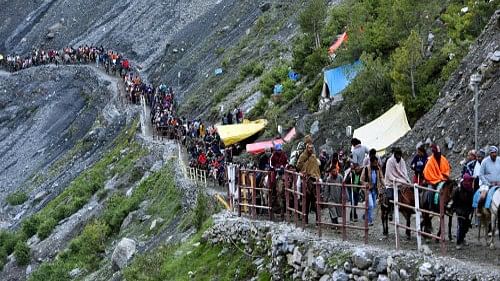
File photo of Amarnath Yatra.
Credit: PTI Photo
The annual Amarnath Yatra, set to begin on June 29 this year, is a deeply revered pilgrimage for millions of Hindus, with historical and social significance. This journey to the abode of Lord Shiva in the south Kashmir Himalayas is steeped in ancient lore, with the cave's naturally occurring ice lingam symbolizing the Guardian of the Absolute and dating back thousands of years.
Legend has it that Lord Shiva revealed the secret of immortality (Amar Katha) to Parvathi in the cave, situated at 3,888 meters above sea level. Though it was mentioned in Puranas, the local folklore has a Muslim shepherd Buta Malik ‘re-discovering’ it. A Sufi saint gave Malik a bag of coal, which turned into a bag of gold coins. He went out again to look for the saint but instead discovered the cave shrine with the ice lingam.
The Yatra, in an organised form, began in 1934 under Dogra ruler Maharaja Hari Singh. It was halted during the partition in 1947 but resumed in 1949 with the intervention of Sardar Vallabhbhai Patel, India's first home minister. The pilgrims travel 46 km from Pahalgam or 14 km from Baltal base camps to reach the cave, navigating steep, winding mountain trails by foot or riding on ponies, pithus, or palkis.
Terror threats to Yatra
The annual pilgrimage is a big challenge for the security forces as it attracts hundreds of thousands of devotees to a historically volatile region, especially in light of potential terror threats.
After the Lok Sabha elections, which saw a good turnout, successfully holding the Yatra this year would demonstrate that the administrative machinery in Jammu and Kashmir is well-prepared and capable of handling the logistical and security challenges for the assembly polls in the Union Territory.
On June 16, Union Home Minister Amit Shah chaired a high-level meeting to assess the security situation in J&K and the preparations for the upcoming Yatra.
In response to recent terror incidents in the Jammu region, the Centre has deployed over 500 companies of Central Armed Police Forces (CAPFs) to ensure that the Yatra proceeds smoothly. Senior officials from the army, police, CRPF, and BSF have held several meetings to review the security situation for the upcoming Yatra.
J&K police chief R R Swain acknowledged the ongoing threats, stating that enemy forces aim to disturb the peace. However, he assured that the security forces are taking all intelligence seriously and working tirelessly to maintain security.
“It (a successful yatra) would reflect improved security, political stability, administrative readiness, and public confidence, all of which are essential for holding free, fair, and credible elections,” said a senior official.
The Yatra has faced numerous terror threats in the past. In 1994, Pakistan-based Harkat-ul-Ansar banned the pilgrimage to protest the demolition of Babri Masjid in Ayodhya. Despite threats, the Yatra continued even during peak militancy years.
However, in 2000, the terrorists killed 25 people, including 17 pilgrims, at the Pahalgam base camp. More such attacks occurred over the next two years, but major incidents ceased after 2002. The Yatra has persisted despite unrest in Kashmir, such as the 2008 protests over land transfers to the Shrine Board.
In 2017, a terror attack on a pilgrim bus killed seven people. Between 1990 and 2017, 53 pilgrims were killed, and 167 were injured in 36 attacks on the Yatra.
Environmental concerns
Environmental challenges also necessitate regulating the Yatra. In 2022, flash floods at a base camp near the cave shrine killed over a dozen pilgrims and injured several others. The construction of a road to the cave shrine last year sparked controversy, with some Kashmiri Pandits and opposition parties warning of ecological catastrophe.
Sanjay Sapru, a social activist, emphasized the need to balance the sanctity of the Yatra with environmental preservation. “There has to be balance. Simply increasing the number of pilgrims each year should not be the sole indicator of its success,” he told DH.
He said the Yatra symbolizes true Kashmiriyat as continuous support of Kashmiri Muslims has always been crucial for ensuring the seamless conduct of the religious pilgrimage, regardless of the circumstances in the Valley.